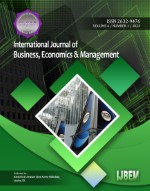How the American dollar exchange effect on foreign direct investment and trade balance?
A case in Indonesia during 2000-2019
Keywords:
foreign direct investment, trade balance, US Dollar exchange rateAbstract
This study aims to determine the direct and indirect effects between the variables that are the object of research, namely the US Dollar exchange rate, foreign direct investment, and the trade balance in Indonesia. The data used is secondary data for the period 2000-2019. The data analysis technique used is path analysis with the help of the SPSS 27.00 program. Based on the results of the analysis of the variable US dollar exchange rate which has a negative effect on foreign direct investment, the US dollar exchange rate has a positive effect on the trade balance and foreign direct investment does not affect the trade balance. The US Dollar exchange rate has no indirect effect on the trade balance through foreign direct investment in Indonesia from 2000-2019.
Downloads
References
Adiyudawansyah, A., & Santoso, D. B. (2012). Analisis Faktor-Faktor Yang Mempengaruhi Foreign Direct Investment Di Lima Negara ASEAN. Jurnal. Malang: Universitas Brawijaya.
Ahmad, D. N., & Stevenson, D. D. G. (2012). The Effect of GDP & Exchange Rate on the Trade Balance Between the United States and Mexico. Journal of Business Management Dynamics,(Mar., 29-2012).
Almfraji, M. A., & Almsafir, M. K. (2014). Foreign direct investment and economic growth literature review from 1994 to 2012. Procedia-Social and Behavioral Sciences, 129, 206-213. https://doi.org/10.1016/j.sbspro.2014.03.668
Arize, A. C., Malindretos, J., & Igwe, E. U. (2017). Do exchange rate changes improve the trade balance: An asymmetric nonlinear cointegration approach. International Review of Economics & Finance, 49, 313-326. https://doi.org/10.1016/j.iref.2017.02.007
Ashraf, M. A., & Joarder, H. R. (2009). Factors affecting volatility of Bangladesh trade deficit: An econometric analysis. ABAC Journal, 29(2).
Basri, M. C., & Patunru, A. A. (2012). How to keep trade policy open: the case of Indonesia. Bulletin of Indonesian Economic Studies, 48(2), 191-208.
Bibi, S., Ahmad, S. T., & Rashid, H. (2014). Impact of trade openness, FDI, exchange rate and inflation on economic growth: A case study of Pakistan. International Journal of Accounting and Financial Reporting, 4(2), 236.
Boediono, D. (2002). Ekonomi Mikro Edisi Kedua. Yogyakarta: BPFE.
Federica & Ratna J. (2013). Pengaruh UMP, Ekspor, dan Kurs Dollar Terhadap Investasi Asing Langsung di Indonesia Periode 2007-2012. Jurnal Jurusan Manajemen STIE MDP.
Ferrero, A. (2010). A structural decomposition of the US trade balance: Productivity, demographics and fiscal policy. Journal of Monetary Economics, 57(4), 478-490. https://doi.org/10.1016/j.jmoneco.2010.04.004
Ginting, A. M. (2014). Perkembangan neraca perdagangan dan faktor-faktor yang mempengaruhinya. Buletin Ilmiah Litbang Perdagangan, 8(1), 51-72.
Ginting, A. M. (2015). Pengaruh Penanaman Modal Asing Terhadap Neraca Perdagangan ASEAN-6. Buletin Ilmiah Litbang Perdagangan, 9(1), 45-62.
Hailu, Z. A. (2010). Impact of foreign direct investment on trade of African countries. International Journal of economics and Finance, 2(3), 122-133.
Irawan, J., Widiyanti, M., Fuadah, L. L., & Isnurhadi, I. (2022). The effect of net trade cycle, firm size, and networking capital on profitability with cash holdings as intervening variables in cement companies in Indonesia. International Journal of Business, Economics & Management, 5(1), 6-10. https://doi.org/10.21744/ijbem.v5n1.1823
Kennedy, O. (2013). Kenya’s foreign trade balance: An empirical investigation. European Scientific Journal, 9(19).
Khan, M. Z. S., & Hossain, M. I. (2012). Determinants of trade balance of Bangladesh: A dynamic panel data analysis. The Bangladesh Development Studies, 45-65.
Krugman, P. R., & Obstfeld, M. (2000). Ekonomi Internasional Teori dan Kebijaksanaan.
Lane, P. R., & Milesi-Ferretti, G. M. (2002). External wealth, the trade balance, and the real exchange rate. European Economic Review, 46(6), 1049-1071. https://doi.org/10.1016/S0014-2921(02)00160-5
Lindblad, J. T. (2015). Foreign direct investment in Indonesia: Fifty years of discourse. Bulletin of Indonesian Economic Studies, 51(2), 217-237.
Liu, Z. (2002). Foreign direct investment and technology spillover: Evidence from China. Journal of comparative Economics, 30(3), 579-602. https://doi.org/10.1006/jcec.2002.1789
Lumbanraja, G. T. (2006). Analisis Pengaruh Foreign Direct Invesment Terhadap Nilai Tukar Rupiah. Skripsi. Bogor: Institut Pertanian Bogor.
Mankiw, N. G. (2006). The macroeconomist as scientist and engineer. Journal of economic perspectives, 20(4), 29-46.
Mankiw, N. G. (2007). The open economy Revisited: the Mundell-Fleming model and the exchange-rate regime.
Mensah, L., Obi, P., & Bokpin, G. (2017). Cointegration test of oil price and us dollar exchange rates for some oil dependent economies. Research in International Business and Finance, 42, 304-311. https://doi.org/10.1016/j.ribaf.2017.07.141
Nanga, M. (2001). Makro Ekonomi Teori, Masalah dan kebijakan edisi pertama. Jakarta: PT RajaGrafindo Persada.
Nazeer, A., Shafi, K., Idrees, Z., & Hua, L. (2015). Exchange rate and determinants of balance of trade, its impact on balance of payment. American Journal of Business, Economics and Management, 3(1), 14-18.
Neumayer, E., & Spess, L. (2005). Do bilateral investment treaties increase foreign direct investment to developing countries?. World development, 33(10), 1567-1585. https://doi.org/10.1016/j.worlddev.2005.07.001
Ng, Y. L., Har, W. M., & Tan, G. M. (2008). Real exchange rate and trade balance relationship: An empirical study on Malaysia. International Journal of Business and Management, 3(8), 130-137.
Norouzzadeh, P., & Rahmani, B. (2006). A multifractal detrended fluctuation description of Iranian rial–US dollar exchange rate. Physica A: Statistical Mechanics and its Applications, 367, 328-336. https://doi.org/10.1016/j.physa.2005.11.019
Nugraha, I. W. Y. (2013). the Impact of Corruption and Money Laundering on foreign Direct Investment in asEaN. Jurnal Ekonomi Kuantitatif Terapan, 6(2), 106-111.
Rahmawati, D. M. (2014). Pengaruh Kurs dan GDP terhadap Neraca Perdagangan Indonesia Tahun 1980-2012. Economics Development Analysis Journal, 3(1).
Sukirno, S. (2000). Makroekonomi modern. Jakarta: PT Raja Drafindo Persada.
Tambunan, R. S. (2015). Pengaruh Kurs, Inflasi, LIBOR, dan PDB Terhadap FDI di Indonesia. Jom Fekom, 2(1).
Tempo. (2013). Defisit Neraca Perdagangan Catat Rekor Terbesar.
Wang, Y., Wu, C., & Pan, Z. (2011). Multifractal detrending moving average analysis on the US Dollar exchange rates. Physica A: Statistical Mechanics and its Applications, 390(20), 3512-3523. https://doi.org/10.1016/j.physa.2011.05.023
Wilson, P., & Tat, K. C. (2001). Exchange rates and the trade balance: the case of Singapore 1970 to 1996. Journal of Asian Economics, 12(1), 47-63. https://doi.org/10.1016/S1049-0078(01)00072-0
Published
How to Cite
Issue
Section
Copyright (c) 2023 International journal of business, economics & management

This work is licensed under a Creative Commons Attribution-NonCommercial-NoDerivatives 4.0 International License.
Articles published in the International Journal of Business, Economics & Management (IJBEM) are available under Creative Commons Attribution Non-Commercial No Derivatives Licence (CC BY-NC-ND 4.0). Authors retain copyright in their work and grant IJBEM right of first publication under CC BY-NC-ND 4.0. Users have the right to read, download, copy, distribute, print, search, or link to the full texts of articles in this journal, and to use them for any other lawful purpose.
Articles published in IJBEM can be copied, communicated and shared in their published form for non-commercial purposes provided full attribution is given to the author and the journal. Authors are able to enter into separate, additional contractual arrangements for the non-exclusive distribution of the journal's published version of the work (e.g., post it to an institutional repository or publish it in a book), with an acknowledgment of its initial publication in this journal.














